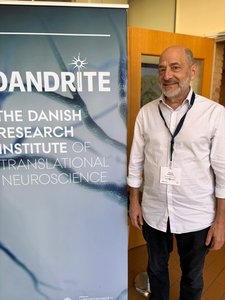
Q: Why did you accept the invitation to give a keynote lecture at the DANDRITE Symposium?
A: There were several reasons. First, I always enjoy coming to Denmark. I received the Brain Prize two years ago, and with that comes an expectation of maintaining a presence here—speaking and engaging with the scientific community. That was certainly a motivating factor.
In addition, I had met several colleagues at various meetings who made me aware of the strong research environment in Denmark, particularly in molecular and cellular neuroscience. This is an area directly related to my own interests, and I anticipated that the talks here would be highly relevant—which they have been.
At many neuroscience meetings nowadays, molecular and cellular neuroscience is underrepresented, especially in relation to how activity influences the genes that I study. The fact that this symposium foregrounded those topics was an important incentive for me to attend.
Q: After listening to the talks, what insights or impressions are you taking away?
A: I wouldn’t say I was surprised, but I was very excited to see researchers using the most advanced technologies to tackle important questions. That was inspiring. What did surprise me, however, was how widespread the use of these modern technologies has become.
Where I work, much of this innovation is developed, and it’s easy to fall into the belief that it only happens there. But clearly, that is not the case, which is encouraging to see.
Q: How do you see this field, particularly the study of brain adaptability, developing in the future?
A: The methodologies are now in place for us to make major advances in understanding how the brain works and what goes wrong in neurological and psychiatric diseases. The unfortunate limitation is not the tools, but the people. There are simply not enough neuroscientists, neither in Denmark nor in the United States.
We are in a position to make enormous progress, but the amount of funding and the number of researchers dedicated to the field are insufficient. If we had ten times as many people, I believe we could make ten times the progress.

Q: Why did you accept the invitation to give a keynote lecture at the DANDRITE Symposium?
A: There were several reasons. I had heard a great deal about DANDRITE and the Lundbeck Foundation, and I have a deep appreciation for the work being done here. It felt both an honour and an exciting opportunity to contribute.
I also have a personal connection to Aarhus. My very first student was a visiting student from Aarhus University—an exceptionally talented researcher, perhaps the best I have ever had. When I asked him to stay with me in New York, he replied, “Absolutely not, I want to return to Aarhus.” That left a strong impression on me, and I knew there must be something very special about this place. That was 20 years ago, and I am delighted to finally be here myself.
Q: How does your research relate to the theme of adaptability in the brain?
A: The theme is perfectly aligned with my research. Adaptability and plasticity are central to what we study, with a particular emphasis on the role of epigenetics in regulating these processes. In my lab, we focus on microglia—arguably the most plastic cells in the brain. Microglia respond rapidly to a wide range of stimuli, but they appear to retain very little memory of these changes. This is in sharp contrast to neurons, which tend to be more stable and retain changes over time. Comparing these two cellular systems allows us to uncover fundamental mechanisms of brain adaptability.
Q: After two days of presentations, what insights are you taking away from the symposium?
A: What struck me most is that while our central conceptual questions remain unchanged, the technological landscape around us is advancing at an extraordinary pace. The integration of artificial intelligence, particularly in analyzing large datasets at the single-cell level, is opening up new possibilities. AI-based approaches will help us trace cells through space and time in the brain, raising profound questions: Can we follow them? Do we understand their prior experiences? And how does that history shape their behavior? These remain some of the most exciting challenges for the coming years.
Q: Could you see yourself returning for a future symposium?
A: Absolutely. Travel here is not the easiest—I came via Norway, and it was a bit of a journey—but it is well worth it. Beyond the science, I had the chance to visit the ARoS Modern Art Museum, which was fantastic. The combination of cutting-edge science and vibrant art in Aarhus is truly inspiring. I am already looking forward to returning, especially with such a strong program of speakers ahead.
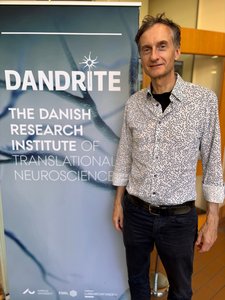
Q: Why did you accept the invitation to give a keynote lecture at the DANDRITE Symposium?
A: DANDRITE has an excellent reputation. It is a young and dynamic center, and I think you can see that reflected in the number of ERC grants that researchers here have received. There is a real sense of excitement and momentum around the institute. I have written recommendation letters for people applying here, and they were very enthusiastic about joining. So when I was invited, it was clear to me that this was a place worth visiting.
Q: How does your research connect to the symposium’s theme of adaptability in the brain?
A: Our work spans developmental biology and sleep research, with a strong molecular and genetic orientation—particularly on the developmental side. This overlaps with the symposium’s focus. In fact, when I visited the poster session, I realized that at least half of the posters were directly relevant to my own research interests. So there was a strong connection.
Q: After a full day of presentations, what insights or new perspectives are you taking away?
A: One of the most striking talks for me was by Taro, who presented on M6A long-term recording. I think this represents a major breakthrough. We have conducted our own work on permanent recording methods—using DNA editing—but those still allow for changes. What impressed me about Taro’s approach was the ability to create a kind of snapshot and then trace what happens over time. That was a very exciting development.
Q: Looking ahead, where do you see this field of brain adaptability moving?
A: The direction will depend greatly on the vision of the director or leadership of the group. The field could move toward more applied research with organoids, patient studies, and psychiatric applications. However, I believe there remains a vast amount to be discovered on the fundamental side. Very few people today are doing basic neuroscience at a sophisticated mechanistic level, and I think that is where DANDRITE can distinguish itself. Large-scale datasets, patient cohorts, and disease models are important, but focusing on deep mechanistic insights is what will truly make this institute unique.
Q: Could you see yourself returning for a future symposium?
A: Absolutely. I would gladly return. I must say, though, it is a long journey. Traveling from Basel required going through Zurich, then Copenhagen, then Aarhus, and finally taking a bus from the airport. If the meeting were held in Copenhagen, it would certainly be more convenient. But being here in Aarhus also has advantages—it creates a special atmosphere. The setting is beautiful and slightly secluded, which encourages people to stay for the entire meeting rather than just dropping in for their own talk. That sense of immersion makes the symposium unique, and I would recommend it to anyone.
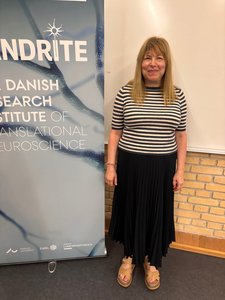
Q: Why did you accept the invitation to speak as a keynote at the DANDRITE Symposium?
A: I was very excited about the topic. I began my career studying activity-regulated genes, and at the time, it felt somewhat premature—the importance of these genes for synaptic function and plasticity wasn’t widely recognized. In recent years, however, there has been a kind of renaissance in this area, and it is finally receiving the recognition it deserves. That made the symposium particularly appealing.
I also enjoy coming to Europe because it is a great opportunity to recruit. There are many outstanding biochemists here, and I had a Danish postdoc who was exceptionally well-trained. In fact, much of the molecular work in my lab has been carried out by European postdocs. I feel that training in biochemistry and molecular biology is stronger in Europe than it currently is in the U.S., so outreach here is valuable.
On a more personal note, I had never been to Denmark before. I was also curious to learn more about DANDRITE and its research community, and since I had already met Chao, the invitation felt like a natural fit.
Q: How does your research connect with the theme of adaptability in the brain?
A: My primary research interest is brain plasticity—the brain’s capacity to adapt. Early on, I approached this through activity-regulated genes, reasoning that identifying these genes would provide mechanistic insights into plasticity. That work continues, but in parallel, I developed an imaging platform to study plasticity at the synaptic level in vivo. This allows us to directly observe synapses forming and disappearing, giving us a clearer picture of what the genes we study are actually doing.
This approach has broadened my perspective: beyond the molecular mechanisms, I am now deeply interested in the basic behavior of synapses themselves, and I see strong connections to the work of many colleagues here who also study plasticity at the synaptic level.
Q: After listening to the talks at the symposium, what insights are you taking back with you?
A: One of the most interesting developments for me has been the increasing focus on cell specificity—and even synapse specificity—in plasticity research. When I first started, we studied activity-regulated genes across the whole brain. Today, technology allows us to examine specific cell types, or even particular synapses, at high resolution.
This has led me to reconsider assumptions I had early in my career. I used to think all synapses had plastic potential, but now I wonder whether only certain synapses are truly plastic. That shift has important implications: when we think about repair or recovery from damage, the potential lies in targeting those elements of the brain that can adapt, rather than trying to induce plasticity where it doesn’t naturally exist. The talks here have reinforced for me this more granular view of plasticity, and it is becoming a more consolidated idea in my mind.
Q: Where do you see this field heading in the coming years?
A: It is always difficult to predict, but I think the most exciting direction is moving beyond cell types to synapse-level resolution. Some of the work we heard about—for example, from Chao Sun —illustrates how powerful and necessary this shift could be. The synapse-specific perspective remains both fascinating and mysterious, and I think it represents a critical frontier for the field.
Q: Could you see yourself returning for a future DANDRITE Symposium?
A: Yes, I would certainly consider coming back.
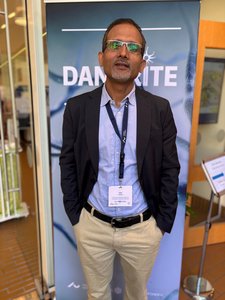
Q: What brought you to the DANDRITE Symposium today?
A: I was invited by the organizers to speak, and when I reviewed the program I was immediately excited, as it directly aligned with my research interests. I also knew many of the colleagues attending, so I accepted right away. The enthusiasm has only grown since this morning—the engagement has been excellent, and the quality of the talks very high.
A highlight for me was the opening lecture by Michael Greenberg, last year’s Brain Prize winner. His work on neuroactivity and neuroplasticity, particularly its connection to transcription regulation by transcription factors, has been groundbreaking. I have followed his research for many years, and today he presented a compelling story that represents over a decade of work. It was wonderful to see those results come to fruition.
I was also very inspired by talks from colleagues including Alex, Min, Taro and Jørgen’s lab. But perhaps the most exciting part for me was the poster session. There, you can interact with young scientists—from master’s students to PhD candidates and postdocs, and even an assistant professor. These discussions are stimulating, as you can ask questions, offer ideas, and help spark new directions for their research.
Q: How does your research connect with the theme of the symposium?
A: My research focuses on the mechanisms of gene regulation during brain development and on how these mechanisms are disrupted in neurodevelopmental disorders. Since the core theme of the symposium is gene regulation in the nervous system, my work fits directly at the heart of the discussion.
Q: If you had to summarize one key insight you are taking away—particularly related to adaptability in the brain—what would it be?
A: In one sentence: the rewiring of gene expression programs is critical for nervous system function, including both cell identity and plasticity. We should recognize the importance of our gene regulatory program in enabling this dynamic rewiring, which is essential for the brain to adapt and function.
Q: Could you see yourself returning for a future DANDRITE Symposium?
A: Certainly—perhaps even sooner than two years. In fact, I will be back here in just about 10 days, on September 2nd, to help organize the first annual meeting of the Danish Neurodevelopmental Disorder Consortium, which will take place in this very auditorium.
And of course, I am also looking forward to the next DANDRITE Symposium. The researchers here are doing excellent, pioneering work that overlaps significantly with my interests. It will be a pleasure to continue following and contributing to this community.
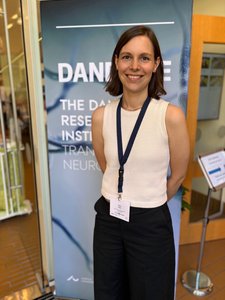
Q: What motivated you to attend the DANDRITE Symposium?
A: I was invited by Taro to join the meeting, and I found the program highly compelling. The line-up of speakers and the overall structure of the symposium were both very impressive.
Q: Could you describe the focus of your research and how it connects with the symposium’s theme?
A: My research centers on early brain development, using human brain organoids as a model system. Specifically, we investigate the gene regulatory processes required for pluripotent cells in the early embryo to differentiate into diverse tissue structures with multiple cell types. The symposium aligns closely with this work, as many of the discussions explored how disruptions in these processes contribute to neurodevelopmental disorders, as well as how neuronal activity influences gene regulation. Broadly, the focus is on understanding the interplay between external signals received by a cell and the regulatory mechanisms within the nucleus that drive cellular decision-making.
Q: After listening to the presentations, what insights are you taking away from the symposium?
A: Several ideas stood out. One particularly interesting theme was the exploration of how a cell changes its fate—for example, whether the expression of a transcription factor reliably passes on through cell lineage, or whether assumptions about cellular progeny may be misleading without direct lineage tracing. It was also inspiring to see how emerging technologies are enabling researchers to tackle such fundamental questions. Another key takeaway concerned how neuronal activity shapes the transcriptome—specifically, how transcription factors identify their genomic targets and drive gene expression changes that support the formation and maintenance of neural circuits. Altogether, the symposium successfully bridged developmental biology, molecular neuroscience, and systems-level perspectives.
Q: Looking ahead, where do you see this field developing over the next decade?
A: While we now have a growing understanding of phenomena in brain development, the underlying molecular mechanisms remain incompletely understood. Many of the talks pointed to the need for a deeper mechanistic explanation—why the loss of a given factor leads to a particular phenotype in the brain, for instance. I believe the next decade will be focused on uncovering these causal links at the molecular level.
Q: Would you be interested in returning to the DANDRITE Symposium in 2027?
A: Absolutely. I would very much look forward to attending again.
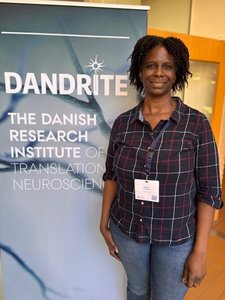
Q: What brought you to the DANDRITE Symposium?
A: I used to work with Chao Sun when we were colleagues at the Max Planck Institute for Brain Research in Frankfurt. Although he is a few career steps ahead of me, we have always stayed in contact and followed each other’s work. He was the one who invited me to the symposium.
Q: What is the main focus of your research?
A: My research examines the impact of metabolic dysregulation in the context of neurodegeneration. I have developed a mouse model that closely mimics the clinical features of metabolic syndrome—a cluster of conditions including hyperglycemia, central obesity, and hypertension. Metabolic syndrome is a major risk factor for neurodegenerative disorders, as well as diabetes and cardiovascular disease. My work aims to understand how these metabolic disturbances may be linked to the clinical features observed in patients with such disorders.
Q: Today’s theme has been gene regulation and adaptability in the brain. After listening to the talks, what specific insights are you taking away?
A: Often the emphasis is placed on neural circuits and higher-order circuit functions, but I believe it is equally important to examine the underlying regulatory mechanisms. In particular, transcription factors play a critical role. For example, MEIS2—a gene highly relevant to my own studies—illustrates how transcription factor regulation can influence not only cell development, but also cellular physiology, ultimately shaping cortical circuit dynamics. This deeper perspective on gene regulation and adaptability is something I found especially valuable today.
Q: Would you consider returning for the next symposium in two years?
A: Absolutely. I have already heard that there may be a focus on microglia–circuit interactions at the next meeting, which I would be very excited to see. I would also look forward to presenting more of my own data in the future.